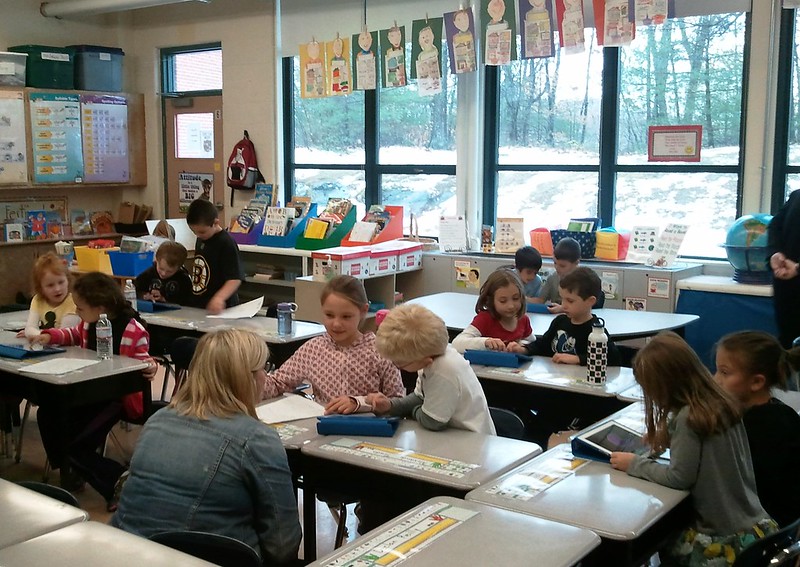 |
| Photo Credit to Massachusetts Education Secretary Matt Malone on Flickr |
Focus Question: How does assistive technology support efforts by teachers to reach all learners?
Assistive technology as defined in the book: "modifies the interface between students and material so that the material becomes more accessible" (p. 284). The addition of assistive technology has made education a much more tangible pursuit for students with disabilities such as hearing, sight, mobile and cognitive impairments. While assistive technology has bridged a path for such students, it is also a successful means to reach all students. The electronic speller and dictionary is an example of an assistive technology that is beneficial for all students. This device allows the student to read, listen and practice vocabulary words and definitions. With text on the screen as well as an option to listen to the words via headphones, the device is accessible to nearly all children, no matter the impairment. Calculators, speech recognition software, text reading softwares and interactive storybooks are more examples of assistive technologies that can support a teacher's effort to reach all students. Although there is controversy regarding how much technology is appropriate in the classroom and lives of children; I don't think anyone can disagree on how beneficial assistive technology can be for the educational experience when used appropriately.
The assistive technology in this video is a great example of how it can be beneficial for all students. While the technology program is marketed for children with learning disabilities or ESL students, the creative and writing process can be difficult to master for anyone. I will add, I was surprised to learn just how expensive the software program is!
Tech Tool Link: Extra-large and Online Calculators
Extra-large calculators can be very beneficial because they are light weight, yet easier to read due to their bigger size. According to the text:
This can also lead to a classroom discussion on the ever shrinking screen that comes along with technology. Students could brainstorm on the positive and negative consequences of being exposed daily to smaller print. By introducing the technology, discussing it and investigating it the students will be more inclined to try it out for themselves. Online calculators are another beneficial tool for not only students, but all individuals. Jim Martindale's Calculators On-Line Center allows for students to try out many online simulations and modules. This is a great tool for practice outside of the classroom. Personally, I have used an online calculator and math program, and it helped me so much. I was able to step-by-step review the material while inputting the data all on the same screen, I had fewer distractions and a better comprehension."Students are more interested in this product than a smaller one because of its different size and style (p. 286)."
Summary & Connection:
I believe the main purpose and goal of teaching is to give your students the tools and guidance necessary to succeed. Technology has become a major assistant in this process, and while it is not entirely the forefront of educational experience; it's collaboration with differentiated instruction and UDL help promote and effective learning environment for all students. Assistive technologies are extremely beneficial for students with disabilities, and they are also highly important for students without. All students can gain support and knowledge with the support of the teacher and assistive technologies. Teachers are not at disposal of technology, they have the opportunity and option to create their classroom using technology. Low tech, middle tech, and high tech options provide the teacher with various choices when incorporating technological changes into their room. It is no longer a question of why one should incorporate technology into the learning environment, it is not a how question and that question is being met with endless opportunities.
And remember...
 |
| Photo credit to Scott McLeod on Flickr |
Resources:
Maloy, Robert, Verock-O’Loughlin,Ruth-Ellen, Edwards, Sharon A., and Woolf, Beverly Park (2011). Transforming Learning with New Technologies. Boston, MA: Pearson Education, Inc. ISBN:10 0-13-159611-X, ISBN:13 978-0-13-159611-5
The technologies designed for special needs students are very often universal in nature and can be used in a variety of settings with all students. Kidspiration is an offshoot of Inspiration software and both are very useful. They do offer an app which is considerably less expensive as an alternative. And there are free web 2.0 tools that are very similar in function/design but probably lack some of the features. Also, note that Scott McLeod (your 2nd Flickr shot) is a professor (Iowa St, I believe) who blogs and is a leader in the educational technology field ... in addition to creating good posters for Flickr! :)
ReplyDelete